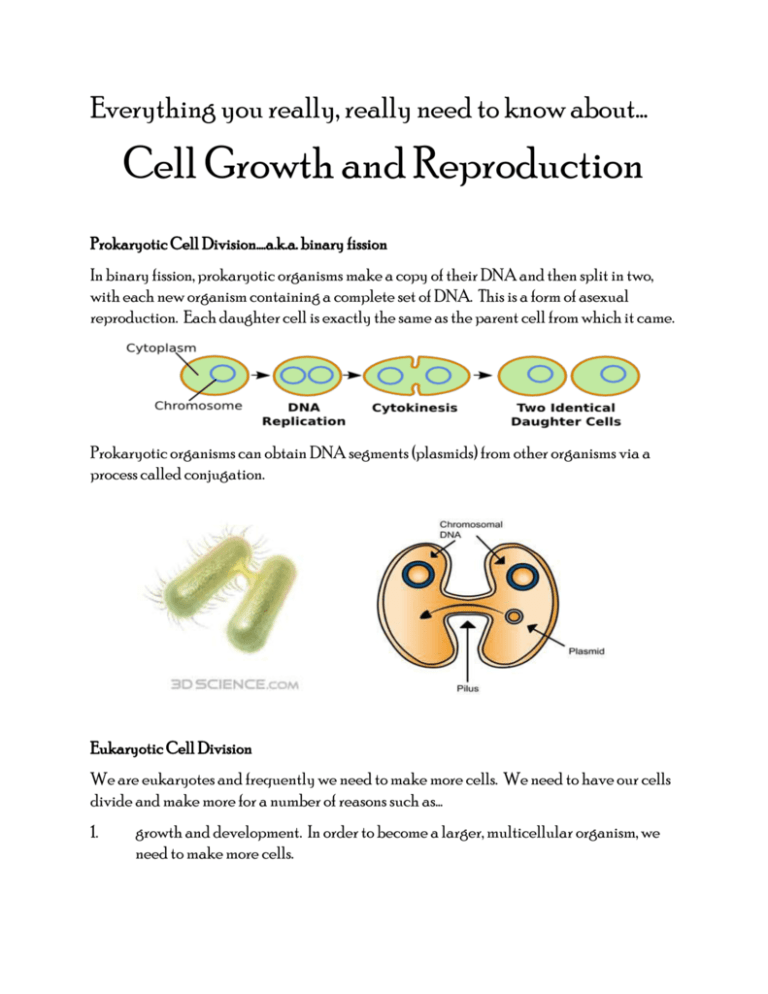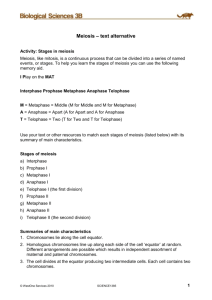Prokaryotic Cell Division….aka binary fission
advertisement

Everything you really, really need to know about… Cell Growth and Reproduction Prokaryotic Cell Division….a.k.a. binary fission In binary fission, prokaryotic organisms make a copy of their DNA and then split in two, with each new organism containing a complete set of DNA. This is a form of asexual reproduction. Each daughter cell is exactly the same as the parent cell from which it came. Prokaryotic organisms can obtain DNA segments (plasmids) from other organisms via a process called conjugation. Eukaryotic Cell Division We are eukaryotes and frequently we need to make more cells. We need to have our cells divide and make more for a number of reasons such as… 1. growth and development. In order to become a larger, multicellular organism, we need to make more cells. 2. replacing dead cells. Our cells have a life span. We’re constantly losing dead skin cells and red blood cells. These need to be replaced. 3. repairing damaged tissue. If you fall and skin your knee, the healing process is largely comprised of cells dividing to repair the damaged area. 4. DNA overload. Cells grow. They become larger, but they can become too large. If they’re allowed to continually grow, they become too large to be controlled by the DNA within the nucleus. By dividing, the size of the cells is continually being cut down to a manageable size. 5. surface area to volume ratio. The problem again is cell growth. As cells get larger, they’re demands increase. Raw materials need to be brought into the cell through the cell membrane. The problem is that the cell membrane’s growth doesn’t keep pace with the growth of the cell in volume and the cell can’t keep pace with providing itself with all the raw materials that are necessary. Now that you know why cells divide, the question becomes, “How do cells divide?”. There are stages to a cell’s life and each plays a role in continuing the cellular division process. Interphase: This stage is a non-dividing portion of the cell’s life. Interphase can be broken up into three smaller stages; G1, S and G2. During G1, the cell grows and makes more organelles for itself. During S, the chromosomes within the nucleus are replicated. For humans, that means that our 46 monad chromosomes become 46 dyad chromosomes, with each chromosomes’ sister chromatids being held together at the centromere. In replicating all the chromosomes, the cell is preparing an entire extra set of chromosomes so that it can eventually divide itself in half, thus providing each new cell with a complete set of genetic material. S is followed by G2, in which the cell gets ready to divide. Cell division (or the M phase) is now set to start and the first part of cell division is known as mitosis. Mitosis deals with the splitting of the chromosomes (or nucleus) and is divided up into four stages. Prophase: During prophase, the nuclear envelope starts to break down, chromosomes become visible, the centrioles move toward the poles of the cell and spindle fibers radiate out from the centrioles. Metaphase: While in metaphase, the cell’s chromosomes are lined up on the equator of the cell, with spindle fibers from each end of the cell attaching to the dyad chromosomes. Anaphase: During anaphase, the spindle fibers shorten, ripping the dyad chromosomes in half, with each sister chromatid heading in opposite directions. Telophase: Once in telophase, new nuclear membranes form around each of the two sets of chromosomes. Telophase is the last stage of mitosis, but cell division is not yet complete. The division of the cytoplasm must be take place. This is called cytokinesis and you can see that it’s already starting to occur during telophase. ….and then interphase starts all over again. Two daughter cells have been created that should be identical to each other as well as being identical to the original parent cell that we started with. The cells that are produced via mitotic cell division can be described as diploid cells. In other words, they contain a full set of chromosomes. Having a full set of chromosomes is perfect for all cells except sex cells (gametes). They need to have half the number of chromosomes so that when they fuse together during fertilization, the resulting zygote will contain a full set. Therefore, a second cell division process must be used to create gametes. This process, called meiosis, must take our diploid cells and cut the chromosome number in half, to produce haploid cells. These will then become either sperm cells or egg cells. The process of meiosis is very similar to mitosis, but with a few important differences. First of all, there are two cell divisions that take place in meiosis, meiosis I and meiosis II. Thus, you end meiosis with four cells instead of just two. Interphase: This is the same as in mitosis. Meiosis I: Prophase I: This is also the same as in mitosis except that sometimes, homologous chromosomes will become intertwined and swap pieces of genetic material, thus leading to greater genetic variety within a population. This is called crossing over. Metaphase I: Once in metaphase I, the cell does something very different than in metaphase of mitosis. The chromosomes line up on the equator, but they do so with their homologous partner. Each dyad chromosome is attached to only one spindle fiber. Anaphase I: As the spindle fibers shorten, they don’t rip the dyad chromosomes in half, but instead, they separate the homologous pairs. Telophase I: The cell can now start to reform its nuclei and begin cytokinesis. The most important thing to note is that the number of chromosomes that will end up in the two daughter cells has now been cut in half. The cells have gone from being diploid, to being haploid. After cytokinesis, the cells will advance into meiosis II. The reason for meiosis II is that, although the chromosome number has been divided in half, the chromosomes themselves are still dyad instead of monad. This needs to change and meiosis II will take care of that because all the steps are exactly the same as mitosis. There are a few differences in the way that males go through meiosis vs. females. The male version of meiosis is called spermatogenesis and the female version is called oogenesis. The main difference is that while males ultimately make four sperm cells, females only make one egg. The other three cells produced by the female are called polar bodies and they are destroyed. The reason for this is that the egg needs to supply all the nutrients for the resulting zygote prior to the embryo forming a physical connection (umbilical cord) with the mother. By dividing unequally, the cytoplasm that normally would have gone into four separate cells is instead all packed into one, giant egg cell.









